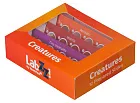Bresser Biolux Touch LCD 40–1400x Digital Microscope - Exhibition Item
LCD touch screen. Magnification: 40–350x. Digital zoom: 1400x. LED illumination
| Product ID | 76190 |
| Brand | Bresser GmbH, Germany |
| Warranty | 2 years |
| EAN | 2400000042501 |
| Package size (LxWxH) | 37x21x16 cm |
| Shipping Weight | 2.25 kg |
Special price! Further discounts or special offers cannot be applied in this case.
Exhibition copy.
Open Box item. A new, unused item with absolutely no signs of use. The item is missing its original packaging or the packaging is damaged.
Otherwise, the product is fully functional.
Exhibition copies cannot be exchanged or returned for a refund. The Bresser Biolux Touch microscope with LCD touch screen is a digital model with wide application. The upper and lower LED illumination makes it possible to observe objects under reflected and transmitted light. The images are displayed on the large LCD screen with a magnification of up to 1400x. The microscope is perfect for work in groups as well as for teaching, as it's very convenient for several people to observe objects on the screen at the same time. The observation results are saved on an SD memory card, and can be transferred to a PC. The touch screen allows for easy photo and video capture, as well as for adjusting the custom settings such as magnification or image sharpness with the onscreen touch menu. The kit includes a massive set of accessories: prepared and blank slides, shrimp hatchery, flasks with yeast, gum media, etc. It's easy to start exploring the microworld right out of the box with this microscope. To view the observed objects, an SD memory card must be inserted into the card slot. You can transfer the observation results to a PC using a USB cable, or read the memory card with a card reader. Features The kit includes: System requirements:
| Product ID | 76190 |
| Brand | Bresser GmbH, Germany |
| Warranty | 2 years |
| EAN | 2400000042501 |
| Package size (LxWxH) | 37x21x16 cm |
| Shipping Weight | 2.25 kg |
| Type | digital |
| Microscope head type | digital screen/PC monitor |
| Magnification, x | 40–1400 (digital), 40–350 (optical) |
| Objectives | 4x, 10x, 50x |
| Revolving nosepiece | for 3 objectives |
| Stage features | with clips |
| Diaphragm | diaphragm disc |
| Focus | coarse |
| Illumination | LED |
| Brightness adjustment | ✓ |
| Power supply | AC adapter |
| Additional | 4.35'' LCD touch-screen |
| Ability to connect additional equipment | supports SD memory cards up to 32GB |
| Application | school/educational |
| Illumination location | dual |
| Research method | bright field |
| Experiment kit included | ✓ |
| Digital camera included | ✓ |
| Maximum resolution | 3648x2048 |
| Megapixels | 5 |
| Sensor element | CMOS |
| Video recording | yes |
| Output | AV, USB |
We have gathered answers to the most frequently asked questions to help you sort things out
Find out why studying eyes under a microscope is entertaining; how insects’ and arachnids’ eyes differ and what the best way is to observe such an interesting specimen
Read this review to learn how to observe human hair, what different hair looks like under a microscope and what magnification is required for observations
Learn what a numerical aperture is and how to choose a suitable objective lens for your microscope here
Learn what a spider looks like under microscope, when the best time is to take photos of it, how to study it properly at magnification and more interesting facts about observing insects and arachnids
This review for beginner explorers of the micro world introduces you to the optical, illuminating and mechanical parts of a microscope and their functions
Short article about Paramecium caudatum - a microorganism that is interesting to observe through any microscope

























